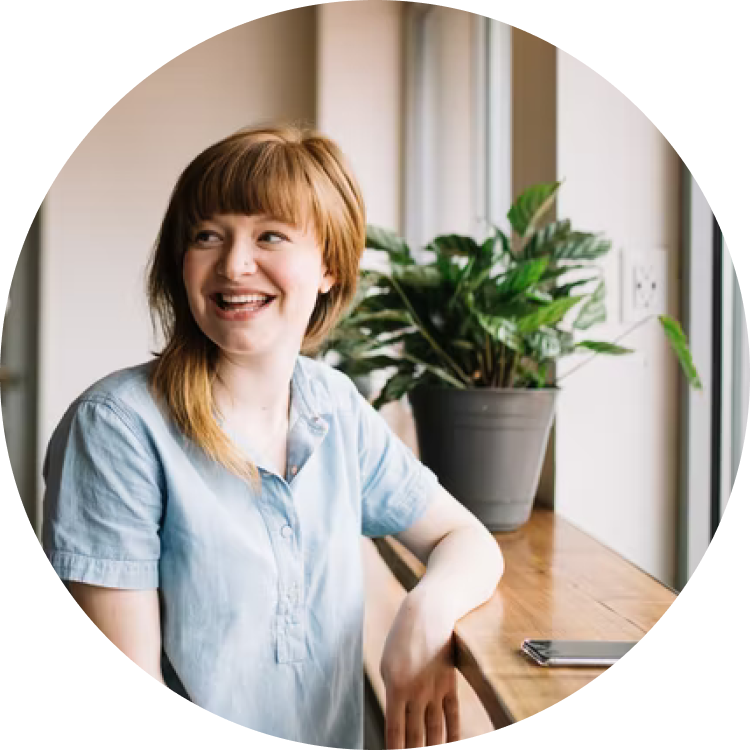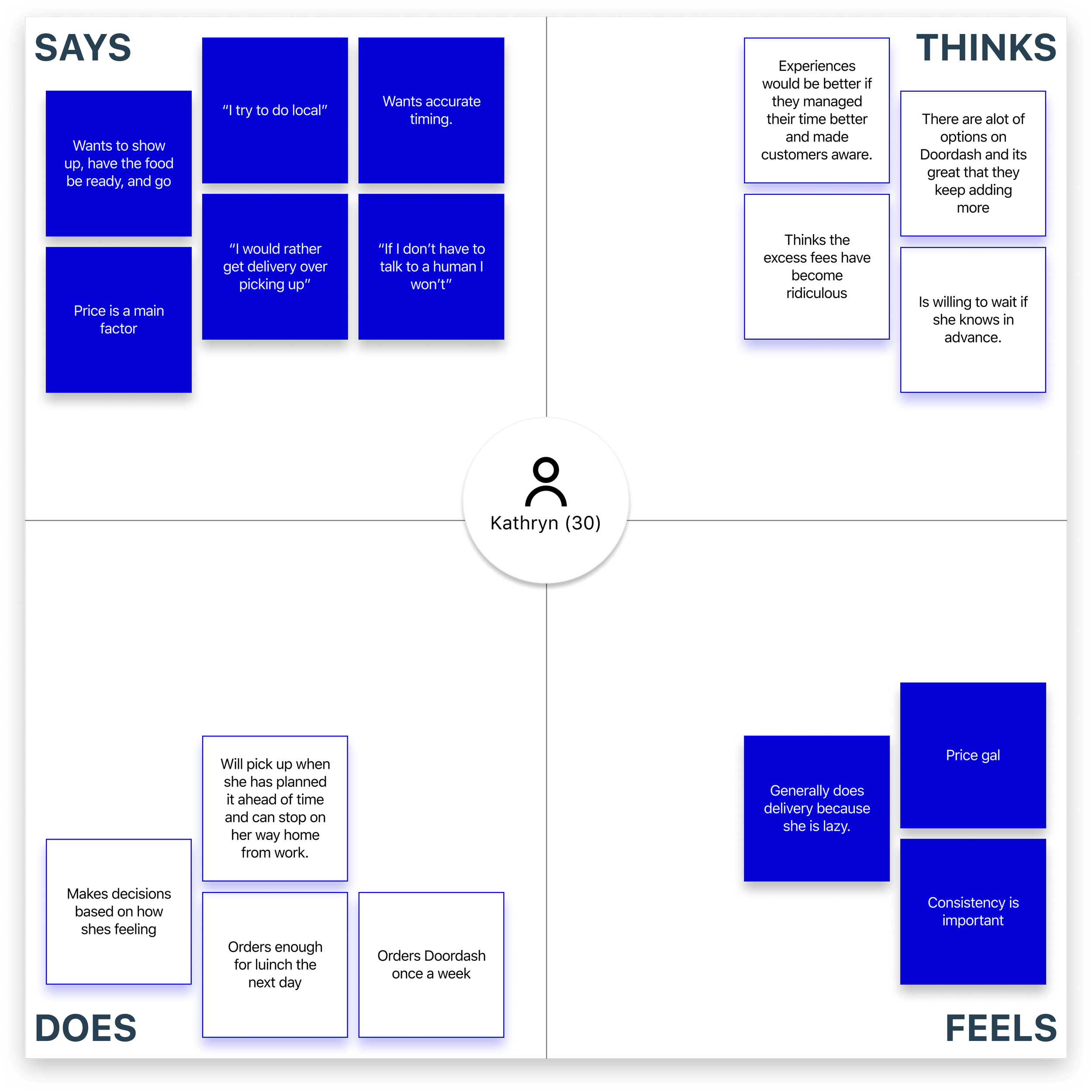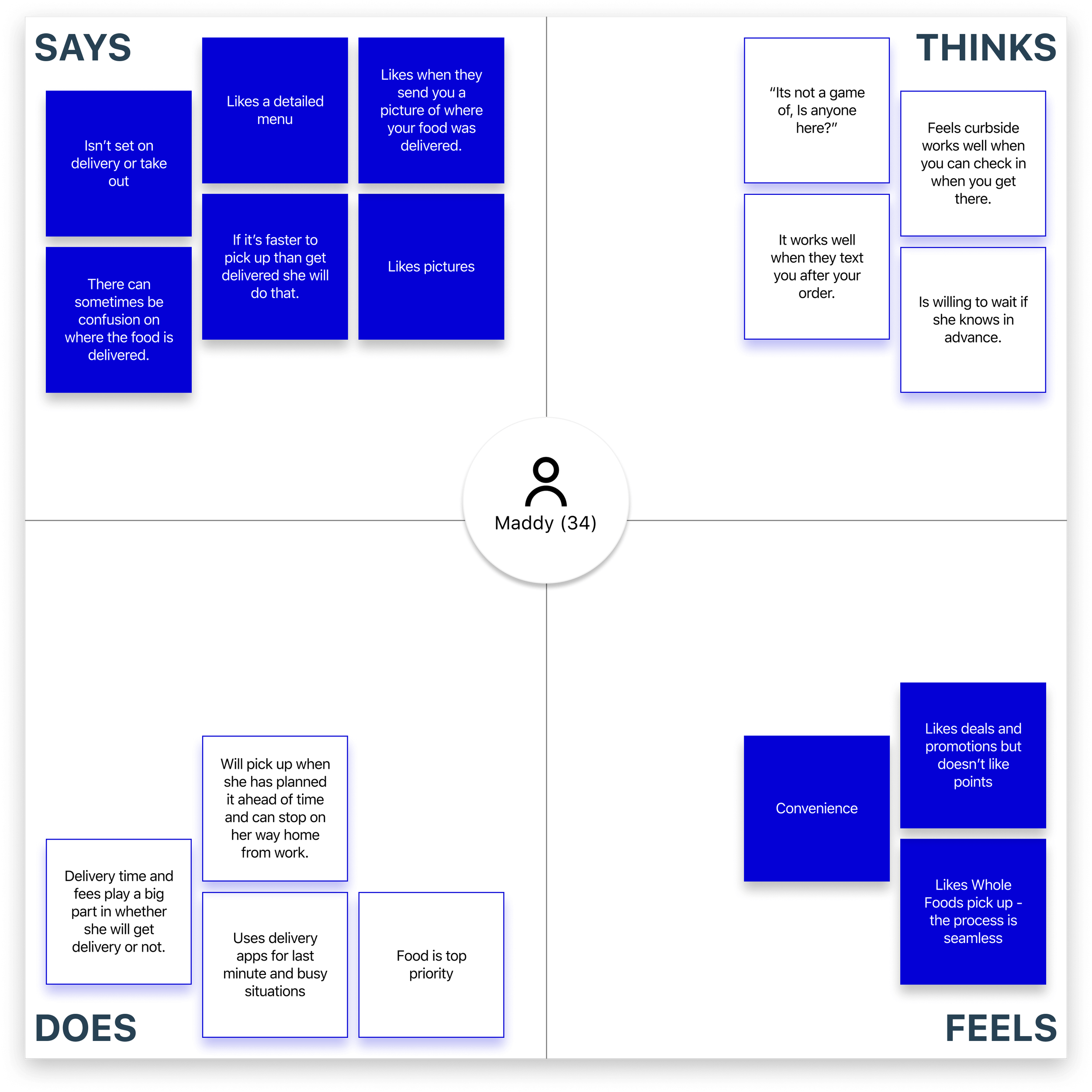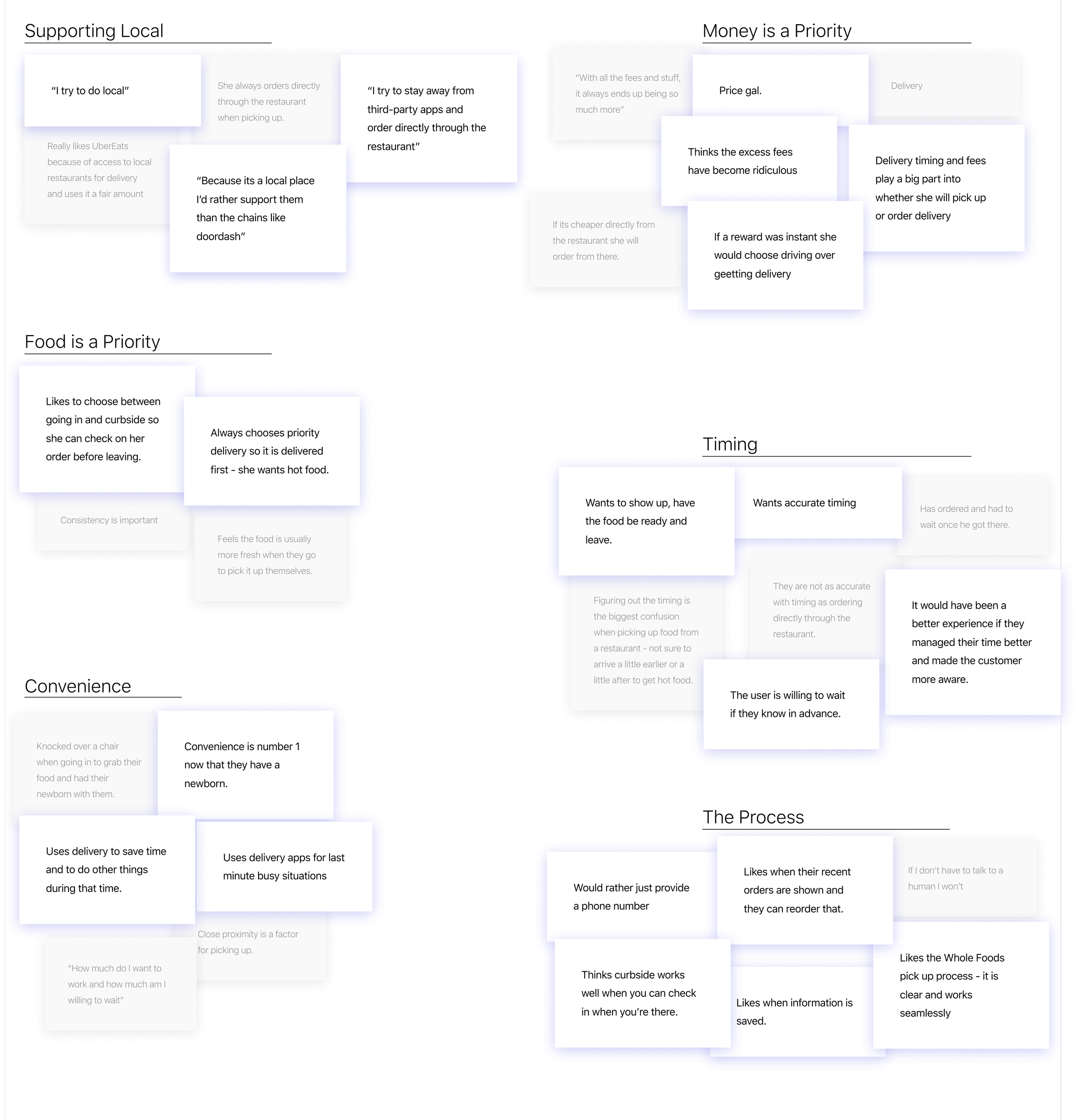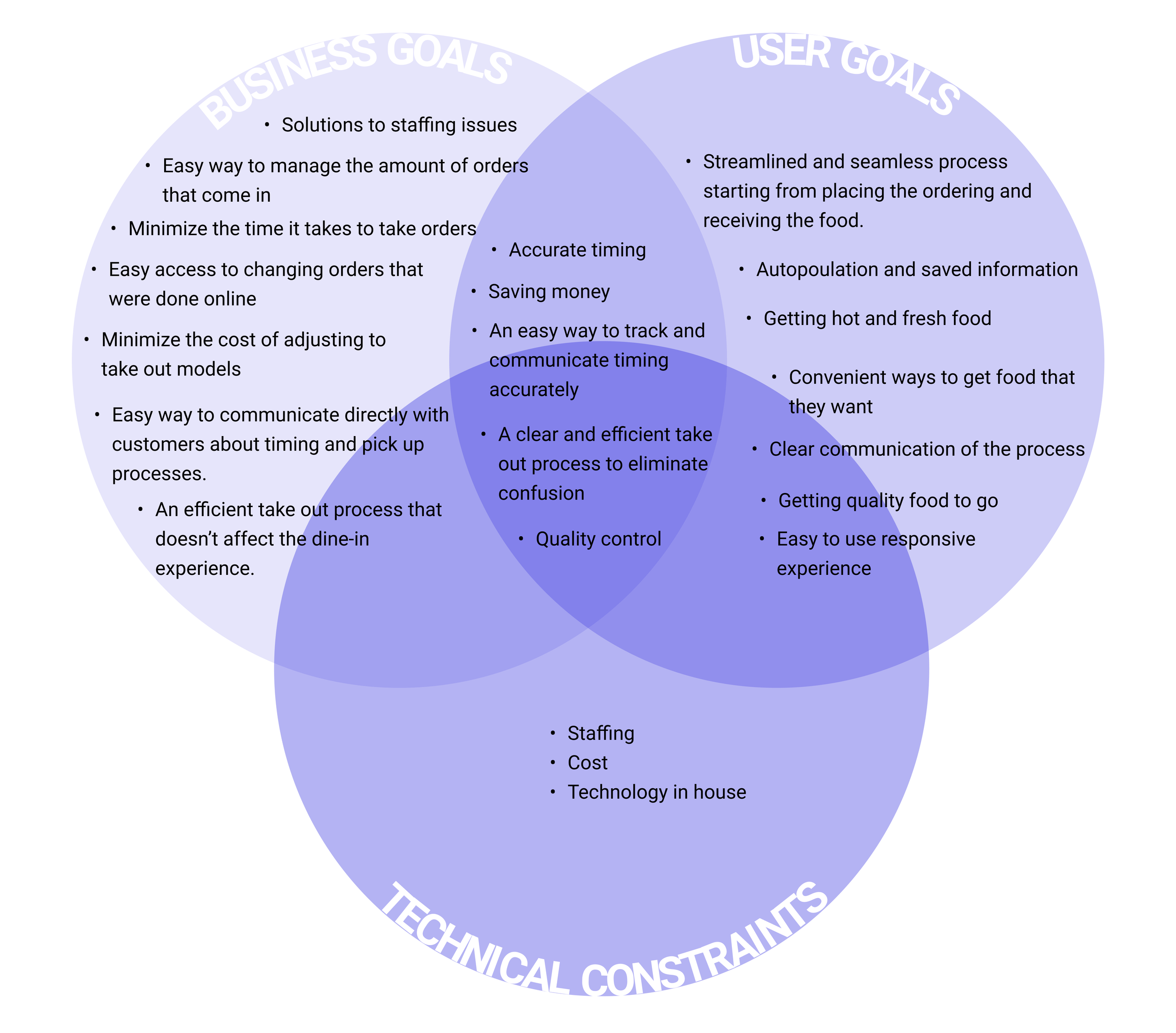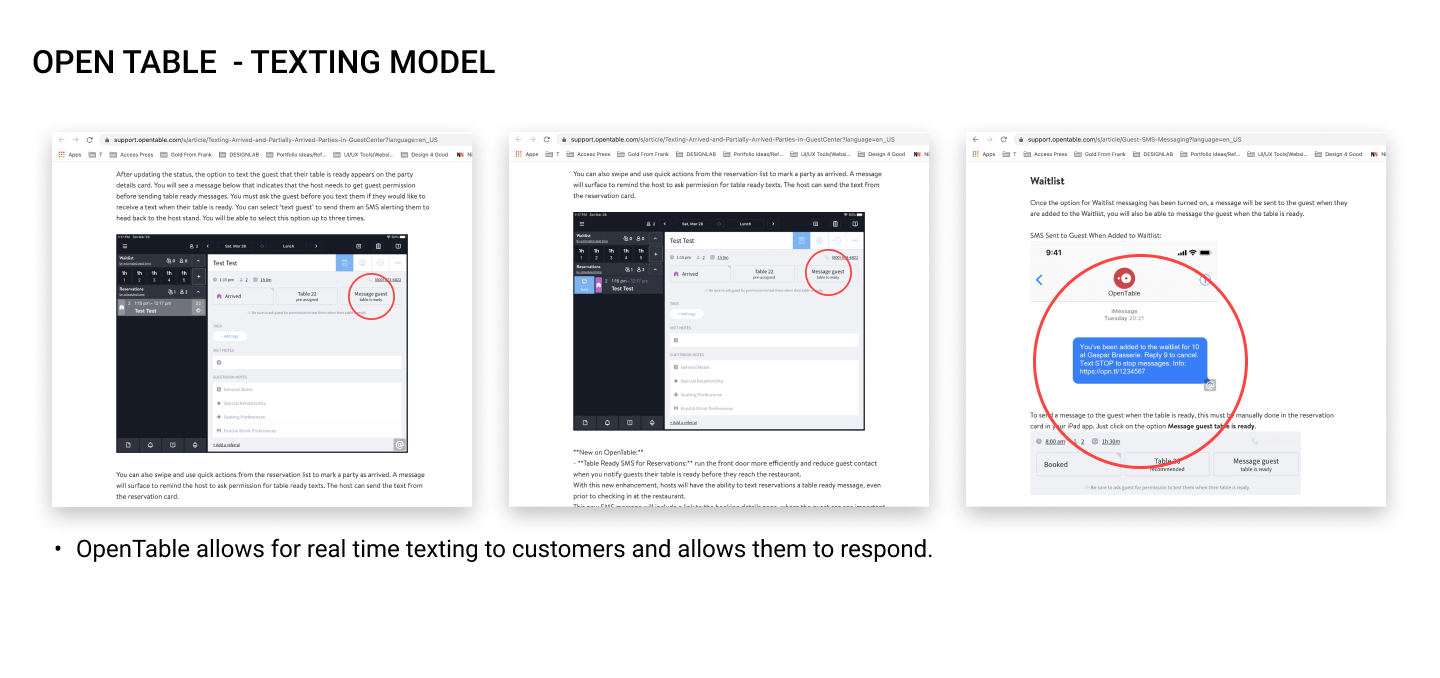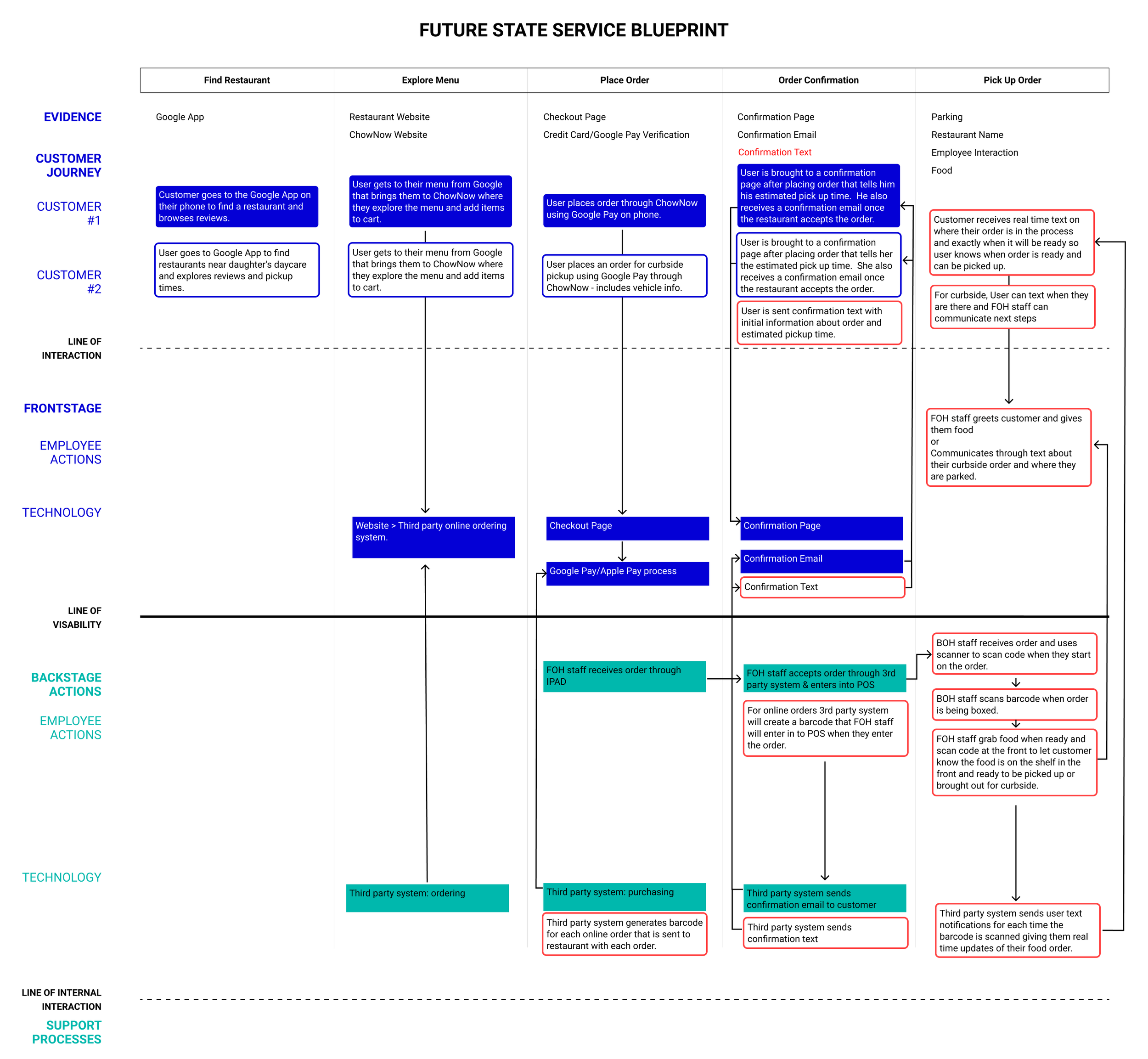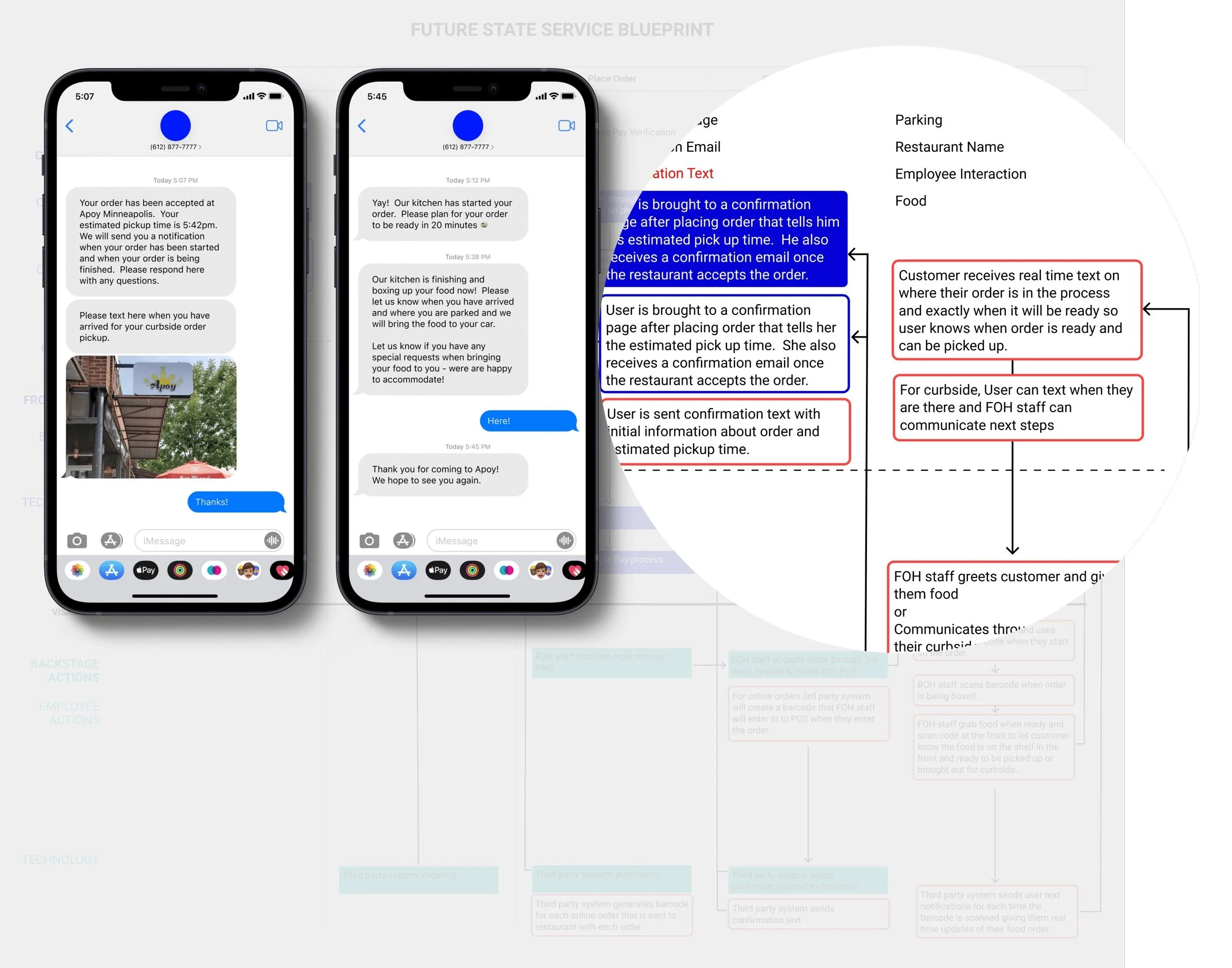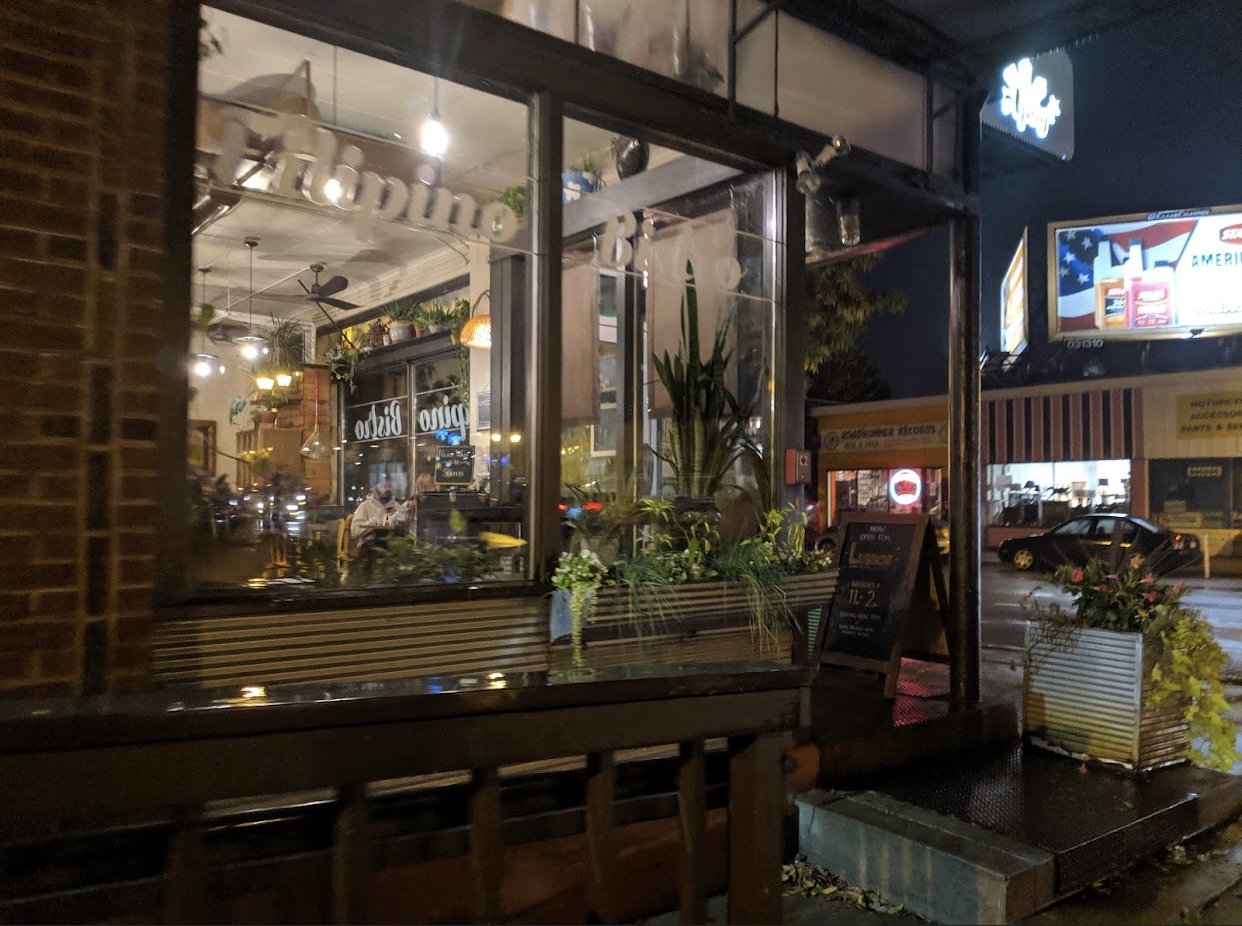
Service Design: The Restaurant Take Out Model
When Service Design is the answer - you dive in.
Design a responsive experience that supports both the staff and the user’s.
Role
UX Researcher
UX Designer
Service Designer
Tools
Figma
Whimsical
Miro
The Beginning
Adapting to the need of solving a problem that directly affects the staff and indirectly the user’s end experience was the name of this game.
The pandemic has changed just about everything as we know it. The restaurant industry was one that was hit hard during the pandemic but one that came out with great innovations in the end. The “Take Out” model is here to stay and making the entirety of that experience positive is what businesses and consumers are looking for.
Small businesses were hit hardest in the industry and backed into a difficult place with big tech companies taking a large part of their thin margins. Creating a system that creates a positive experience for their customers while keeping as much in-house as possible was the goal.
Overview
The Challenge
A local restaurant was faced with issues in nailing down their take-out model. Customers were finding themselves either waiting for their orders or getting cold food. The goal was to streamline this process so they had happy customers.
The Solution
Create a service blueprint using a Service Design approach to improve processes to enhance both their employee’s and customers’ experiences.
*This project was completed as part of DesignLab’s UX Academy program. This project will not be implemented.
The Process
Most of this project was spent in the Discovery and Defining phase and bouncing back and forth between the two.
The initial end solution for this project was a responsive design, but after much research, a Systems Thinking and Service Design approach seemed to be the best solution because of how the problem at hand affected both the customers and the staff behind the scenes.
The problem could not be solved without understanding how these two groups interacted and where they crossed over.
01. DISCOVER
If third-party delivery is here to stay, is it sustainable for small restaurants?
I set out on this mission because I was fascinated by the idea of Third Party delivery systems and how much they offered to restaurants during the pandemic, but in the same breath, how much they took from them.
The research showed me that take-out and delivery models are not going away, even “after” the pandemic. So, how can restaurants adapt to this change in a sustainable way?
Not only do third-party delivery systems take large commissions from restaurants but it takes quality control and personable experiences away from small businesses, which a lot of their establishments are built on.
Finding out what it takes for a user to order directly from a restaurant.
After understanding that to be sustainable, small businesses need to find a way around third-party systems, the quest was to better understand users and their major pain points with take-out and how to enhance that experience so much that customers don’t find a need for third-party systems.
I interviewed 6 restaurant-goers and within these interviews, my goals were to understand:
GOAL #1
Why do users use third-party delivery apps? What do they like and dislike about the experience?
GOAL #2
What pain points do users experience when ordering and picking up directly through restaurants?
GOAL #3
Understand what users value in restaurants and what motivates them to order directly through them rather than a third-party app.
What are the problems those forced to adjust are facing?
I worked with a local restaurant as my client and was able to sit down with them and ask them questions about their experience adjusting to take-out and delivery models because of the pandemic. I was curious about what their biggest pain points are within that process.
“Timing. People respond differently to order times - some arrive early, some arrive late.”
“The amount of time it takes to sit on the phone with people, whether it’s to order food or about where they are supposed to pick up their food.”
“There’s no real way to communicate with customers after their order has been placed and prior to arriving so people get confused about where to pick up their food.”
Visualizing what was said by the users + comparing it to the responses from those in the industry.
TAKEAWAYS: Restaurant + User Interviews
Customer’s actions + words don’t always match when it comes to how they get their food.
Affinity Mapping helped me get to the bottom of what users really wanted in their experience by grouping what they said - they say they want it to be cheap, convenient, and fast but what is really their top priority? What do they care about the most and what can they forget about?
TAKEAWAYS: Affinity Mapping
02. DEFINE
With two user types, their perspectives needed to be looked at individually to enhance cohesivity in the restaurant.
There are two different types of customers: pickup and curbside.
These different customers require different things from the business and needed to be looked at individually from the end-users perspective but collectively from the business side.
I needed to figure out a cohesive system for the business side and a specialized experience on the user’s side.
Learning where they cross over + the need for service design.
After getting a clear understanding of where the user’s and restaurants’ pain points are in the take-out process I needed to figure out why these issues were happening.
A Systems Thinking and Service Design approach was needed because of the interaction between the restaurant and its users and the number of touchpoints. This was the point that really changed the course of my project and helped me start to use different tools and focus on System Thinking to solve the problem (that had not yet been defined).
Finding where the pain points arrive in the process.
The customer journey maps helped me define where in the process the users were experiencing their pain points. Even though the users had different looking end goals (one was take-out and one was curbside) - for both of their experiences their pain points were at the very end of their experience - why? What was happening that both were experiencing this at the same points of their experience and what could be changed on the business side to change that outcome? Why was this happening?
Customer Journey vs Service Blueprint swim lanes
After making the current state service blueprint I put it side-by-side the customer journey maps and looked at where the user’s pain points were and what was going on in the service blueprint during those stages.
There were three main players in the whole process and that was the Customer, the FOH staff in charge of the orders and interacting with the customer, and the BOH staff that was making the food and interacting with the FOH staff.
These swim lanes helped me identify areas where there was a disconnect between each of the players.
TAKEAWAYS: Defining the Problem
And the problems have been defined!
HOW MIGHT WE #1
Give the customer easier access to communicate with the restaurant and necessary information to make a seamless experience in getting quality food?
HOW MIGHT WE #2
Give the FOH online order taker access to real-time communication with the customer?
HOW MIGHT WE #3
Include the BOH staff in the third-party system flow to provide more accurate timing estimates to users + FOH staff?
03. DESIGN
Going back to understand changes being made to adapt to this “new” future for restaurants.
Once I had defined what specific areas within the take-out process needed solutions, I went back to the Discovery phase to better understand the market and the long-term changes restaurants were making to adapt to the new future of restaurants. These were the three main areas of focus:
Digital maturity
Updated operating procedures
Optimized delivery business
What’s out there that works?
Taking what I learned from the market research I looked for places that were executing those needs well while keeping in mind the needs of my client and their customers. I looked at three places:
TAKEAWAYS: Market Research
Shooting for the stars
I designed a future state service blueprint by looking at the areas that I had previously noted were pain points for each participant within the process and created solutions based on the research.
04. DELIVER
A visual representation of the new and improved process.
To bring the experience together, I created a Storyboard of the customer experience that would display the critical touchpoints within the experience to create a greater level of empathy in the implementation through a visual representation.
What are the solutions for each participant involved?
SOLUTION: Back of House Staff
The proposed solution was to add a QR code to TOGO tickets for the kitchen. The BOH staff would then scan the QR code when they start an order and when they are finishing/boxing the order. When the order is scanned it will send a SMS notification to the user about their status as well as update the FOH staff’s device with the status of each order.
This solution was created to loop in the BOH staff into the order status process, update the customer to enhance efficient timing, and provide a way for BOH staff to update everyone in an efficient way that does not interfere with their work.
SOLUTION: Front of House Staff
The proposed solution for the FOH staff has two parts. Part (1) involves a technology enhancement to their online order-taking device.
This would allow them access to customer information (i.e. car details for curbside), notifications of status changes of food, real-time communication capabilities with the customer, and access to their order.
Giving the FOH staff ability to communicate in real-time with customers would allow them to prepare customers for the experience, give them access to easy communication if needed, and free up the phones to enhance efficiency.
Part (2) is setting up a specified area for pickup. This involves sending a picture and information to the customer prior to prep them for what to expect.
SOLUTION: Customer
The proposed solution for the customer is access to real-time communication and updates regarding their order to ensure they are not waiting and that their food is hot.
By enhancing the process backstage the customer is given a more streamlined process.
Next Steps - where to start?
A realistic first place to start is implementing a clear pickup location as well as clear information on the website of how the process will work. Both of those solutions are options that do not require any enhanced technology.
For the other proposed solutions, they may be less accessible or realistic for this specific business. These solutions would either require doing research to find if there is a company that already has these capabilities and if it is realistic within the business’s budget. The other option would be to enhance technology and either add on to an existing product or to create a new product with this type of technology.
Pivoting.
“Don’t vet the solution, understand the problem you are trying to solve.”
I have been told this before and this played out true during this project. This project opened my eyes to the possibility of more dynamic relationships. This specific project could not have been solved with just a digital interface and not all industries want that.
Listening to truly understand the problems but also to what the business wants were key in this project. The client in this situation was a small local restaurant, yes there could have been technology implemented like Domino’s but would that have actually worked for them? When I realized it wouldn’t have was when I knew I had to pivot and look beyond just a digital interface to solve their problem.






